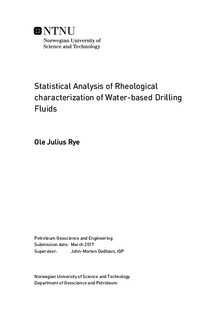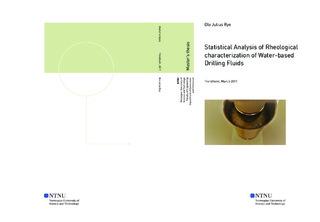| dc.description.abstract | Of fundamental importance in drilling technology is the drilling fluid. It has to counter varying wellbore conditions, and still be able to fulfil its objectives like suspension and transport of solids, pressure control and wellbore stabilization. Viscosity, density and shear behaviour impact the ability to handle these tasks. Rheological properties are being affected when subjected to variations in parameters like temperature, shear stress and pressure. For deeper and longer wells, surrounding conditions is also getting more extreme, which increases the requirements for specialized drilling fluids. In order to design these appropriately, behavioural knowledge is important. Influence of temperature and degradation are two subjects being investigated in more detail in this report. Such information is obtained through manual or automated tests. Reliability for obtained results is essential whether it is by automated or manual means.
This study was a follow up to Priyadharshini Saptahrishi s Master thesis entitled Rheological Characterization of Water-based Drilling Fluids- a Comparative Analysis of Manual and Automated measurements (2016). Questions was raised related to uncertainties and reliability of the experiments involved. This project was trying to verify repeatability, and provide estimates for the uncertainties by the use of statistical methods. Rheological behaviour related to temperature and time dependency was also investigated.
In this report, results from Fann viscometer tests carried out for a selection of fluids containing poly-anionic cellulose (PAC), Xanthan Gum (XG) and barite will be presented. Compositions were chosen on a comparable basis to Saptharishi (2016). By using an increased number of measurements, repeatability could be assessed, and used as a foundation to compare the previously obtained results from Saptharishi (2016).
The results revealed a strict inverse relation between temperature and viscosity as expected. Degradation over time was significant, but varied amongst the compositions. Mixtures of pure PAC, and with additions of barite, had a decrease in viscosity over a time window of 14 days, in the order of 30-75% the lower concentration of PAC being the most stable of these. Samples containing XG had a rapid decrease in viscosity during the first 48 hours, before they did show the most stable behaviour during the rest of the time window. The degradation of fluids makes it important to add stabilizers in order to slow down this rate, and maintain the desired porperties.
The repeatability found in measurements performed during this project appeared to be of a precise nature, with variations from arithmetic mean values in the order of 0.5 to 2.3%. Comparing Saptharishi s (2016) results with 95 % confidence intervals created on the basis of results from this project, none of the compositions did fit. For three compositions, deviations from mean values was in the order of 8-10 %, while the lower concentration of PAC deviated with 28%. On this basis, it was concluded that the experiments could not be assessed as reliable. It was reasonable to ascribe procedural inequalities as of one of the main reasons for this, which emphasizes the need for detailed standardization in procedures in order to obtain comparable and reliable results from experiments. | |

